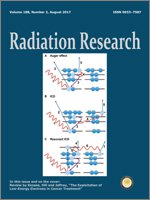Deep-space travel presents risks of exposure to ionizing radiation composed of a spectrum of low-fluence protons (1H) and high-charge and energy (HZE) iron nuclei (e.g., 56Fe). When exposed to galactic cosmic rays, each cell in the body may be traversed by 1H every 3–4 days and HZE nuclei every 3–4 months. The effects of low-dose sequential fractionated 1H or HZE on the heart are unknown. In this animal model of simulated ionizing radiation, middle-aged (8–9 months old) male C57BL/6NT mice were exposed to radiation as follows: group 1, nonirradiated controls; group 2, three fractionated doses of 17 cGy 1H every other day (1H × 3); group 3, three fractionated doses of 17 cGy 1H every other day followed by a single low dose of 15 cGy 56Fe two days after the final 1H dose (1H × 3 56Fe); and group 4, a single low dose of 15 cGy 56Fe followed (after 2 days) by three fractionated doses of 17 cGy 1H every other day (56Fe 1H × 3). A subgroup of mice from each group underwent myocardial infarction (MI) surgery at 28 days postirradiation. Cardiac structure and function were assessed in all animals at days 7, 14 and 28 after MI surgery was performed. Compared to the control animals, the treatments that groups 2 and 3 received did not induce negative effects on cardiac function or structure. However, compared to all other groups, the animals in group 4, showed depressed left ventricular (LV) functions at 1 month with concomitant enhancement in cardiac fibrosis and induction of cardiac hypertrophy signaling at 3 months. In the irradiated and MI surgery groups compared to the control group, the treatments received by groups 2 and 4 did not induce negative effects at 1 month postirradiation and MI surgery. However, in group 3 after MI surgery, there was a 24% increase in mortality, significant decreases in LV function and a 35% increase in post-infarction size. These changes were associated with significant decreases in the angiogenic and cell survival signaling pathways. These data suggest that fractionated doses of radiation induces cellular and molecular changes that result in depressed heart functions both under basal conditions and particularly after myocardial infarction.
How to translate text using browser tools
14 June 2017
Different Sequences of Fractionated Low-Dose Proton and Single Iron-Radiation-Induced Divergent Biological Responses in the Heart
Sharath P. Sasi,
Xinhua Yan,
Marian Zuriaga-Herrero,
Hannah Gee,
Juyong Lee,
Raman Mehrzad,
Jin Song,
Jillian Onufrak,
James Morgan,
Heiko Enderling,
Kenneth Walsh,
Raj Kishore,
David A. Goukassian
ACCESS THE FULL ARTICLE

Radiation Research
Vol. 188 • No. 2
August 2017
Vol. 188 • No. 2
August 2017




